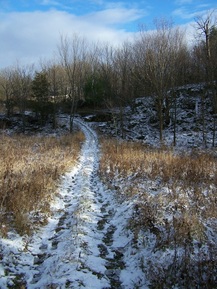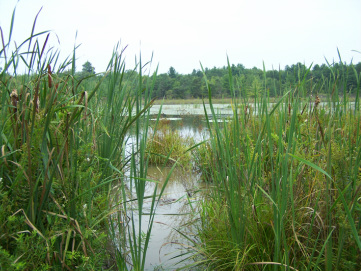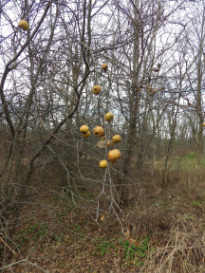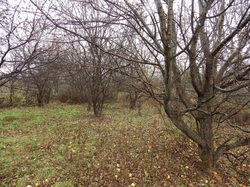 Like many a fool before us, we bought land on a whim. It might have been a whimsey of long standing, but the purchase cannot really be described as sensible. A hundred and some acres of former dairy farm, a ramble with only the rusted ghosts of barbed-wire fences and a tumbledown house to show for it. The property boasts hardwood and piney woods, vast stretches of thorny underbrush, meadows blithely reverting to marsh, deer-hunting stands of uncertain provenance, and a choice assortment of random boulders and sheer granite rock-faces. But a lovely path meanders from the road at the front of the property to the pond at the far end. The path curves through the strips of meadow and upland woods like an invitation. And the pond, ringed with sharp stumps (like huge mute pencils stuck into the soil eraser-end first), has more than one active beaver lodge.  We picked the land for beauty and for the potential of future use. It's no less sensible an investment, look at it from another view, than purchasing art or a fancy-schmancy car. No car, even this one, comes standard with porcupines and kingfishers. It begs the question of why: Why buy land so far from where we live and where we plan to continue living? Why not someplace within easy drive of home? If we meant to spend time with the northern relatives, why not get a summer cottage instead of what the tax office so flatly describes as "wasteland"? In a word: apples.  It's perhaps the single thing I miss by living south of the 38th parallel, and one of those crops that might -- just might -- thrive without a year-round caretaker. We spotted a handful of old trees on the land on our first reconnaissance sorties, so there was potential. Plus, you know, new neural pathways. If a person want to remain relatively sprightly, so the research is showing, she should start early by making new neural pathways in her brain. Move house, start dance lessons, take up fresh hobbies, forge new connections to the world, and put your muscles to work in unexpected ways. Thus was I thinking: maybe start with a dozen apple trees. Get saplings in the spring. Carefully shielded from the deer and the voles, planted in the best-looking stretch of meadow, now THAT's a nice new neural path. The chicken-and-egg quandary about when to sink a well and when to pipe in electricity to pump water out of the well to give the baby trees a drink? Delicious question, because after all, our very own orchard! The neighborly dudes down the road agreed to mow our overgrown pastureland in exchange for the right to hunt over the winter. A sailing friend in the Finger Lakes raises apples; when asked, he agreed to share some insight. And I started taking farming classes through the Cornell University Cooperative Extension.  Ask any wee sleekit cowr'in beastie, and he'll tell you: Plans. Bah! Aft gang agley, plans. Those handful of gnarled old apple-trees that we'd seen while scouting the land? Just the start. Scrambling up and down the ridges, checking the property lines, Jeff and I found two groves of 30+ mature trees -- untouched, I think, by human hand for decades -- and dozens of full-grown volunteers all over the place. In total, perhaps 100 trees. Which has led to the purchase of our first piece of farm equipment: a chainsaw.
10 Comments
Scott Smith
1/17/2014 01:26:01 am
Got the perfect name for your property... Oar, Hill & Sail.
Reply
Amy
1/17/2014 08:51:01 am
Thanks Scott!
Reply
cathmason
1/17/2014 07:44:03 am
Reply
Amy
1/17/2014 08:52:04 am
Thanks Cath --
Reply
yourScothasspreaders!
1/17/2014 12:07:22 pm
Many congratulations! That land will feed yer souls every day, whether you happen to be there or not. A dozen years ago all-time pleasant Scot sailors Mark Fleckenstein and crew would drive their yacht south for the Florida circuit events while also keeping the Florida grocery stores in apples. He may have some helpful apple growin tips for yawl up in NY so give a knock on the door.
Reply
Amy
1/18/2014 11:20:03 am
Thank you!
Reply
george a.
1/18/2014 02:30:24 am
I'm thinking hard cider and apple jack. Probably need a winery (cidery?) license from the state, otherwise you'll be a moonshiner! (I wonder if you can list "moonshiner" as an occupation on your tax return?)
Reply
Amy
1/18/2014 11:27:52 am
Hey George --
Reply
jim
4/27/2015 03:51:05 am
Nicely written, printed out for Pat. I would probably follow the cider/jack route and assume the neural pathways would feast on that!
Reply
Amy
4/27/2015 09:41:43 am
Thanks Jim!
Reply
Leave a Reply. |
About the Blog
A lot of ground gets covered on this blog -- from sailboat racing to book suggestions to plain old piffle. FollowTrying to keep track? Follow me on Facebook or Twitter or if you use an aggregator, click the RSS option below.
Old school? Sign up for the newsletter and I'll shoot you a short e-mail when there's something new.
Archives
June 2024
Categories
All
|
 RSS Feed
RSS Feed
